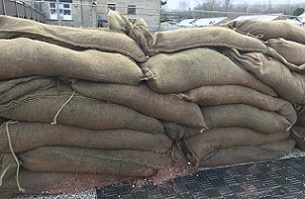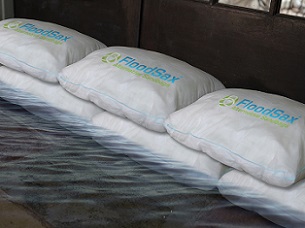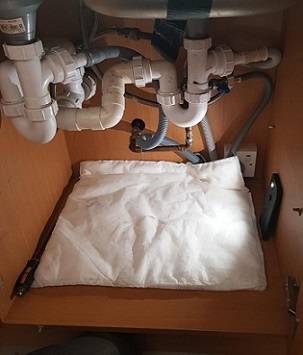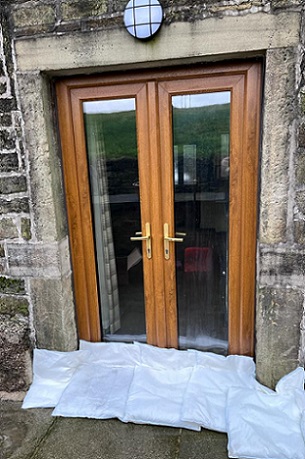 Sandbags are hard to build into flood barriers and can quickly deteriorate and spill sand
Sandbags are hard to build into flood barriers and can quickly deteriorate and spill sand
 FloodSax alternative sandbags are a uniform shape so can make neat and robust anti-flood barriers
FloodSax alternative sandbags are a uniform shape so can make neat and robust anti-flood barriers
 FloodSax are multi-purpose and flexible (unlike sandbags) so can be used inside to soak up leaks and spills
FloodSax are multi-purpose and flexible (unlike sandbags) so can be used inside to soak up leaks and spills
 FloodSax sandless sandbags prove themselves in action time after time
FloodSax sandless sandbags prove themselves in action time after time
Soaring cost of sandbags makes FloodSax alternative sandbags a more cost-effective and convenient option to prevent flooding
An alternative sandbag is more cost-effective and way more convenient than traditional sandbags … and also better at keeping floodwater out of homes and businesses.
People asking ‘how much are sandbags?’ are in for a shock as prefilled sandbags now cost up to £370 for 70 while a box of 20 FloodSax can cost around £140 including free express delivery.
Also be warned that a lot of these old-style sandbags are also way smaller than Floodsax, weighing just 15kg compared to FloodSax which are around 20kg when fully activated. FloodSax are also a uniform shape, unlike sandbags, so are far easier to stack than plastic-coated or hessian-coated sandbags to make robust barriers strong enough to stop a torrent of floodwater.
Sandbags can also quickly deteriorate, fall apart and spill sand. One sandbag company even admits on its website: “Hessian sandbags eventually rot away. Due to their relatively short lifespan, our hessian sandbags are filled to order and we recommend using them within 4 to 6 weeks.”
FloodSax are vacuum-packed so have a shelf life of at least 5 years and will remain effective for around 3 months and probably a lot longer.
One sandbag company promoting its products on Google Ads is selling prefilled sandbags for £165.36 for 20 delivered while another has 35 sandbags for £206 delivered. A typical price for each small traditional sandbag is between £6 and £7 if people only want 20 or so.
A box of 20 FloodSax are available from £140 including delivery from FloodSax Express https://floodsaxexpress.com/ which aims to provide a next-day delivery service.
You’d need at least 20 FloodSax to protect a couple of doors and airbricks for most homes but the recommendation is two boxes so you have enough to stop floodwater getting into patio doors and garages too. That’s £280 including delivery, still almost £100 cheaper than traditional prefilled sandbags from some companies. Their sandbags are also smaller than FloodSax so you’d need even more to try to keep the water out.
Flood experts all agree that traditional sandbags simply don’t work.
The Environment Agency states: “Sandbags are relatively ineffective when compared to purpose-built flood protection products. We strongly encourage people to use these products.”
The Environment Agency also warns that local councils have no responsibility to provide sandbags or any other flood protection, adding: “Don’t assume the authorities will provide you with sandbags in a flood emergency. It is the responsibility of property owners to take appropriate action to protect their property from flooding.”
UK flood expert Mary Dhonau, director of MDA Flood Resilience Consultants and leader of the Know Your Risk Flood Campaign, says: “Sandbags do more harm than good and it frustrates and upsets me to see them continually being used as a go-to solution when they simply don’t work.
“Whenever a flood is imminent, everyone at risk calls for the inefficient and environmentally unfriendly sandbag which I consider to be no more than a ‘comfort blanket’ when a flood emergency happens.
“In a test at an accredited British Standards Institute testing tank four sandbags placed in front of a household door failed after just 59 seconds of the water being turned on while 10 sandbags held water back for just over two minutes.
“The sand that escaped from the bag badly blocked the sump pump used to drain water out of the testing tank. This also happens in real flood conditions and sand often collects in drains afterwards, rendering them inefficient come the next heavy rainfall.”
FloodSax passed all tests under similar conditions and, as they don’t contain any sand, there’s no danger of them clogging up drains. They are also 96% biodegradable by weight making them far more environmentally friendly than traditional sandbags.
Local councils don’t like sandbags either.
Rossendale Council in Lancashire says: “Sandbags are relatively ineffective when compared to purpose-designed flood protection products. As a result, we strongly encourage people to use purpose-made flood protection products.
“Sandbags have disadvantages. During an emergency sufficient quantities may be difficult to obtain, they are time-consuming to lay properly and can be difficult to handle, particularly for the elderly or infirm. The sacking material is biodegradable and will disintegrate if left in place for long periods of time.”
Unlike sandbags, FloodSax are multi-use and multi-purpose. They are incredibly space-saving to store as they are vacuum-packed and in their dry state are ultra-flat with a large surface area which makes them ideal to soak up drips, leaks and spills indoors, especially in hard-to-reach places such as beneath boilers, below radiators and underneath pipes.
But immerse them in water and the gelling polymer inside absorbs the water and then retains it, making the FloodSax miraculously inflate to become an instant sandbag but without any sand.
FloodSax were devised by Yorkshire-based Environmental Defence Systems Ltd and around 3 million have now been sold worldwide.
For more information on FloodSax go to www.floodsax.co.uk